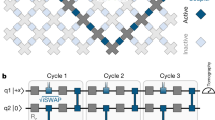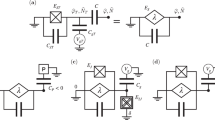Abstract
Topology, with its abstract mathematical constructs, often manifests itself in physics and has a pivotal role in our understanding of natural phenomena. Notably, the discovery of topological phases in condensed-matter systems has changed the modern conception of phases of matter1,2,3,4,5. The global nature of topological ordering, however, makes direct experimental probing an outstanding challenge. Present experimental tools are mainly indirect and, as a result, are inadequate for studying the topology of physical systems at a fundamental level. Here we employ the exquisite control afforded by state-of-the-art superconducting quantum circuits to investigate topological properties of various quantum systems. The essence of our approach is to infer geometric curvature by measuring the deflection of quantum trajectories in the curved space of the Hamiltonian6. Topological properties are then revealed by integrating the curvature over closed surfaces, a quantum analogue of the Gauss–Bonnet theorem. We benchmark our technique by investigating basic topological concepts of the historically important Haldane model7 after mapping the momentum space of this condensed-matter model to the parameter space of a single-qubit Hamiltonian. In addition to constructing the topological phase diagram, we are able to visualize the microscopic spin texture of the associated states and their evolution across a topological phase transition. Going beyond non-interacting systems, we demonstrate the power of our method by studying topology in an interacting quantum system. This required a new qubit architecture8,9 that allows for simultaneous control over every term in a two-qubit Hamiltonian. By exploring the parameter space of this Hamiltonian, we discover the emergence of an interaction-induced topological phase. Our work establishes a powerful, generalizable experimental platform to study topological phenomena in quantum systems.
This is a preview of subscription content, access via your institution
Access options
Subscribe to this journal
Receive 51 print issues and online access
$199.00 per year
only $3.90 per issue
Buy this article
- Purchase on Springer Link
- Instant access to full article PDF
Prices may be subject to local taxes which are calculated during checkout
 .
.
 .
.


Similar content being viewed by others
References
Klitzing, K. v., Dorda, G. & Pepper, M. New method for high-accuracy determination of the fine-structure constant based on quantized Hall resistance. Phys. Rev. Lett. 45, 494–497 (1980)
Tsui, D. C., Stormer, H. L. & Gossard, A. C. Two-dimensional magnetotransport in the extreme quantum limit. Phys. Rev. Lett. 48, 1559–1562 (1982)
Bernevig, B. A., Hughes, T. L. & Zhang, S.-C. Quantum spin Hall effect and topological phase transition in HgTe quantum wells. Science 314, 1757–1761 (2006)
Hasan, M. Z. & Kane, C. L. Colloquium: topological insulators. Rev. Mod. Phys. 82, 3045–3067 (2010)
Moore, J. E. The birth of topological insulators. Nature 464, 194–198 (2010)
Gritsev, V. & Polkovnikov, A. Dynamical quantum Hall effect in the parameter space. Proc. Natl Acad. Sci. USA 109, 6457–6462 (2012)
Haldane, F. D. M. Model for a quantum Hall effect without Landau levels: condensed-matter realization of the “parity anomaly”. Phys. Rev. Lett. 61, 2015–2018 (1988)
Geller, M. et al. Tunable coupler for superconducting Xmon qubits: perturbative nonlinear model. Preprint at http://arXiv.org/abs/1405.1915 (2014)
Chen, Y. et al. Qubit architecture with high coherence and fast tunable coupling. Preprint at http://arXiv.org/abs/1402.7367 (2014)
Thouless, D. J., Kohmoto, M., Nightingale, M. P. & den Nijs, M. Quantized Hall conductance in a two-dimensional periodic potential. Phys. Rev. Lett. 49, 405–408 (1982)
Wen, X.-G. Quantum Field Theory of Many-body Systems (Oxford Univ. Press, 2004)
Bernevig, B. A. & Hughes, T. L. Topological Insulators and Topological Superconductors (Princeton Univ. Press, 2013)
Berry, M. V. Quantal phase factors accompanying adiabatic changes. Proc. R. Soc. Lond. A 392, 45–57 (1984)
Wilczek, F. & Shapere, A. Geometric Phases in Physics (World Scientific, 1989)
Neeley, M. et al. Emulation of a quantum spin with a superconducting phase qudit. Science 325, 722–725 (2009)
Leek, P. J. et al. Observation of Berry’s phase in a solid-state qubit. Science 318, 1889–1892 (2007)
Atala, M. et al. Direct measurement of the Zak phase in topological Bloch bands. Nature Phys. 9, 795–800 (2013)
Mariantoni, M. et al. Implementing the quantum von Neumann architecture with superconducting circuits. Science 334, 61–65 (2011)
Houck, A. A., Türeci, H. E. & Koch, J. On-chip quantum simulation with superconducting circuits. Nature Phys. 8, 292–299 (2012)
Buluta, I. & Nori, F. Quantum simulators. Science 326, 108–111 (2009)
Barends, R. et al. Coherent Josephson qubit suitable for scalable quantum integrated circuits. Phys. Rev. Lett. 111, 080502 (2013)
Schroer, M. D. et al. Measuring a topological transition in an artificial spin-1/2 system. Phys. Rev. Lett. 113, 050402 (2014)
Xu, C., Poudel, A. & Vavilov, M. G. Nonadiabatic dynamics of a slowly driven dissipative two-level system. Phys. Rev. A 89, 052102 (2014)
Feynman, R. P. Simulating physics with computers. Int. J. Theor. Phys. 21, 467–488 (1982)
Acknowledgements
We acknowledge discussions with J. Moore, C. Nayak, M. Niu, A. Rahmani, T. Souza, M. Vavilov, D. Weld and A. Yazdani. This work was supported by the NSF (grants DMR-0907039 and DMR-1029764), the AFOSR (FA9550-10-1-0110), and the ODNI, IARPA, through ARO grant W911NF-10-1-0334. Devices were made at the UCSB Nanofab Facility, part of the NSF-funded NNIN, and the NanoStructures Cleanroom Facility.
Author information
Authors and Affiliations
Contributions
P.R., C.N. and Y.C. designed and fabricated the sample, performed the experiment, analysed the data, and with M.K. and C.Q. co-wrote the manuscript and Supplementary Information. M.K. and A.P. provided theoretical assistance. All members of the UCSB team contributed to the experimental set-up. All authors contributed to the manuscript preparation.
Corresponding author
Ethics declarations
Competing interests
The authors declare no competing financial interests.
Supplementary information
Supplementary Information
This file contains Supplementary Text and Data 1-6 , Supplementary Figures 1-9 and additional references - see Contents list for details. (PDF 5137 kb)
Rights and permissions
About this article
Cite this article
Roushan, P., Neill, C., Chen, Y. et al. Observation of topological transitions in interacting quantum circuits. Nature 515, 241–244 (2014). https://doi.org/10.1038/nature13891
Received:
Accepted:
Published:
Issue Date:
DOI: https://doi.org/10.1038/nature13891
This article is cited by
-
Controllable tunability of a Chern number within the electronic-nuclear spin system in diamond
npj Quantum Information (2023)
-
Circuit quantization with time-dependent magnetic fields for realistic geometries
npj Quantum Information (2022)
-
Stabilizing multiple topological fermions on a quantum computer
npj Quantum Information (2022)
-
Fast topological pumping for the generation of large-scale Greenberger-Horne-Zeilinger states in a superconducting circuit
Frontiers of Physics (2022)
-
Quantum entangled fractional topology and curvatures
Communications Physics (2021)
Comments
By submitting a comment you agree to abide by our Terms and Community Guidelines. If you find something abusive or that does not comply with our terms or guidelines please flag it as inappropriate.



